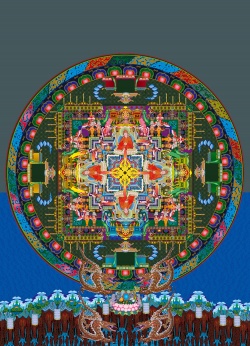Difference between revisions of "The Bodhisattva Ideal"
(Created page with " The Mahayana ("Great vehicle") or Northern branch is one of the two major divisions of Buddhism, the other being Theravada. (This latter kind of ...") |
|||
| Line 1: | Line 1: | ||
| + | <nomobile>{{DisplayImages|1825|534}}</nomobile> | ||
| + | The [[Mahayana]] ("[[Great vehicle]]") or [[Northern]] branch is one of the two major divisions of [[Buddhism]], the other being [[Theravada]]. | ||
| − | + | (This [[latter]] kind of [[Buddhism]] is also referred to derogatively as "[[Hinayana]]" - "[[small vehicle]]"). | |
| + | |||
| + | [[Mahayana Buddhism]] is based on sophisticated [[metaphysical]] speculations regarding the [[nature]] of [[Reality]] ([[shunyata]]), or [[Enlightenment]] ([[sambodhi]], [[prajna]]) and of the [[Buddha]] ([[Trikaya]]). | ||
| + | |||
| + | [[Soteriologically]] of the [[idea]] not of escape into a quiescent [[nirvana]], but rather, having achieved [[Enlightenment]], one returns as a [[Bodhisattva]] to the [[world]] for the [[sake]] of other [[beings]]. | ||
| + | |||
| + | [[Mayahana]] therefore emphasises that the [[duty]] of [[enlightenment]] to work [[compassionately]] to relieve the [[suffering]] of others ([[upaya]] - "[[skillfull means]]"), and argues that all [[sentient]] creatures will ultimately achieve [[Buddhahood]]. [[Mahayana Buddhism]] spread [[northeast]] from [[India]] into [[China]] (1st century A.D.), and from there into [[Tibet]] and [[Korea]], and from [[Korea]] into [[Japan]]. | ||
By convention, [[Mahayana]] is divided into two [[philosophical]] schools, both of which had a strong influence on the various [[Mahayana]] [[Buddhist]] sects, but also the [[Wikipedia:Advaita Vedanta|Advaita Vedanta]] of [[Gaudapada]] and [[Wikipedia:Adi Shankara|Shankara]] as well. | By convention, [[Mahayana]] is divided into two [[philosophical]] schools, both of which had a strong influence on the various [[Mahayana]] [[Buddhist]] sects, but also the [[Wikipedia:Advaita Vedanta|Advaita Vedanta]] of [[Gaudapada]] and [[Wikipedia:Adi Shankara|Shankara]] as well. | ||
| Line 10: | Line 18: | ||
The second [[Mahayanist]] school is the [[Vijnanavada]] or "Consciousness-doctrine" which uses the [[experience]] of [[meditation]] in order to prove that all [[reality]] is ultimately [[Consciousness]] (hence their alternative names of [[Yogachara]] - "[[Yoga]] [[doctrine]]" - and [[Chittamatra]] - "[[mind-only]]"). Unlike the [[Madhyamikas]], they developed a number of [[metaphysical]] and [[occult]] conceptions, [[including]] an [[emanationist]] {{Wiki|ontology}} quite similiar to that of [[Samkhya]], but {{Wiki|psychologically}} rather than [[cosmologically]] orientated. | The second [[Mahayanist]] school is the [[Vijnanavada]] or "Consciousness-doctrine" which uses the [[experience]] of [[meditation]] in order to prove that all [[reality]] is ultimately [[Consciousness]] (hence their alternative names of [[Yogachara]] - "[[Yoga]] [[doctrine]]" - and [[Chittamatra]] - "[[mind-only]]"). Unlike the [[Madhyamikas]], they developed a number of [[metaphysical]] and [[occult]] conceptions, [[including]] an [[emanationist]] {{Wiki|ontology}} quite similiar to that of [[Samkhya]], but {{Wiki|psychologically}} rather than [[cosmologically]] orientated. | ||
| + | |||
The [[Bodhisattva Ideal]] | The [[Bodhisattva Ideal]] | ||
At the [[heart]] of [[Mahayana Buddhism]] is the [[noble]] [[Bodhisattva Ideal]]. | At the [[heart]] of [[Mahayana Buddhism]] is the [[noble]] [[Bodhisattva Ideal]]. | ||
| + | |||
A [[bodhisattva]] is a being who searches for the [[attainment]] of the [[Buddhahood]] for the [[benefit]] of all [[sentient beings]]. This {{Wiki|conception}}, central to [[Mahayana]] school, developed from the original [[idea]] of one who defers the "[[Wikipedia:Absolute (philosophy)|ultimate]] goal" of [[nirvana]] ([[extinction]]) in order to return to the [[world]] of [[suffering]] again & again for the [[sake]] of [[sentient beings]]. | A [[bodhisattva]] is a being who searches for the [[attainment]] of the [[Buddhahood]] for the [[benefit]] of all [[sentient beings]]. This {{Wiki|conception}}, central to [[Mahayana]] school, developed from the original [[idea]] of one who defers the "[[Wikipedia:Absolute (philosophy)|ultimate]] goal" of [[nirvana]] ([[extinction]]) in order to return to the [[world]] of [[suffering]] again & again for the [[sake]] of [[sentient beings]]. | ||
| Line 19: | Line 29: | ||
The [[Bodhisattva]] and [[Reincarnation]] | The [[Bodhisattva]] and [[Reincarnation]] | ||
| − | Evgueni Tortchinov | + | |
| + | |||
| + | [[Evgueni Tortchinov]] | ||
Within the [[Tibetan Buddhist tradition]] we must differentiate two types of the [[reincarnations]]: | Within the [[Tibetan Buddhist tradition]] we must differentiate two types of the [[reincarnations]]: | ||
| − | + | the usual one (the [[interpretation]] of which has the [[doctrine]] of [[Karma]] as its foundation) the [[interpretation]] of which does not differ much from that of the [[Theravadins]] | |
| − | + | ||
| + | the [[doctrine]] of [[Sprul-sku]] (read: tool-koo, [[Sanscrit]]: [[nirmanakaya ]]-- {{Wiki|magically}} produced [[body]], or {{Wiki|magically}} [[transformed]] [[body]])), i.e. the ability of the [[bodhisattvas]] and other [[saints]] ([[arya pudgala]]) to create by the force of [[mind]] special "artificial" [[bodies]] to reveal theirselves to the [[samsaric]] [[world]] by their wiil for the [[benefit]] of the [[living beings]]. | ||
| + | |||
| + | Thus, [[Dalai-lama]] is a [[sprul-sku]] of [[bodhisattva Avalokiteshvara]], [[Panchen-lama]] the [[sprul-sku]] of [[Buddha Amitabha]], [[Bogdo-gegen]] of [[Mongolia]] the [[spruls-sku]] of the [[saint]] [[Taranatha]], etc. | ||
| + | |||
| + | And only such special [[incarnations]] can be realised on the levels of [[mind]], speech and [[body]]. | ||
| + | |||
| + | |||
| + | Moreover, each [[bodhisattva]] by his/her [[supernatural powers]] can produce [[unlimited]] number of such "[[magical]] [[bodies]]" and therefore, to be [[incarnated]] in several persons (we had seen such a [[collision]] in the Bertolucci's "{{Wiki|Little Buddha}}"). | ||
| − | + | In common speach such [[incarnations]] are called "[[incarnated]] [[lamas]]", or even "[[living buddhas]]". | |
| − | + | But [[ordinary beings]] move in the [[wheel]] of the [[cyclic existence]] by the force of their [[karma]] keeping the {{Wiki|unity}} of their "[[santana]]" -- {{Wiki|individual}} continuality of their psyco-phisical [[experience]]. | |
Latest revision as of 07:03, 7 February 2017
The Mahayana ("Great vehicle") or Northern branch is one of the two major divisions of Buddhism, the other being Theravada.
(This latter kind of Buddhism is also referred to derogatively as "Hinayana" - "small vehicle").
Mahayana Buddhism is based on sophisticated metaphysical speculations regarding the nature of Reality (shunyata), or Enlightenment (sambodhi, prajna) and of the Buddha (Trikaya).
Soteriologically of the idea not of escape into a quiescent nirvana, but rather, having achieved Enlightenment, one returns as a Bodhisattva to the world for the sake of other beings.
Mayahana therefore emphasises that the duty of enlightenment to work compassionately to relieve the suffering of others (upaya - "skillfull means"), and argues that all sentient creatures will ultimately achieve Buddhahood. Mahayana Buddhism spread northeast from India into China (1st century A.D.), and from there into Tibet and Korea, and from Korea into Japan.
By convention, Mahayana is divided into two philosophical schools, both of which had a strong influence on the various Mahayana Buddhist sects, but also the Advaita Vedanta of Gaudapada and Shankara as well.
The first is the anti-metaphysical Madhyamika or dialectic school, which emphasises the negation of all possible phenomenal reality through a kind of logical reducto-ad-absurdum, in order to arrive at the ineffable absolute or Void (shunyata) that is the only Reality.
The second Mahayanist school is the Vijnanavada or "Consciousness-doctrine" which uses the experience of meditation in order to prove that all reality is ultimately Consciousness (hence their alternative names of Yogachara - "Yoga doctrine" - and Chittamatra - "mind-only"). Unlike the Madhyamikas, they developed a number of metaphysical and occult conceptions, including an emanationist ontology quite similiar to that of Samkhya, but psychologically rather than cosmologically orientated.
At the heart of Mahayana Buddhism is the noble Bodhisattva Ideal.
A bodhisattva is a being who searches for the attainment of the Buddhahood for the benefit of all sentient beings. This conception, central to Mahayana school, developed from the original idea of one who defers the "ultimate goal" of nirvana (extinction) in order to return to the world of suffering again & again for the sake of sentient beings.
The Bodhisattva and Reincarnation
Within the Tibetan Buddhist tradition we must differentiate two types of the reincarnations:
the usual one (the interpretation of which has the doctrine of Karma as its foundation) the interpretation of which does not differ much from that of the Theravadins
the doctrine of Sprul-sku (read: tool-koo, Sanscrit: nirmanakaya -- magically produced body, or magically transformed body)), i.e. the ability of the bodhisattvas and other saints (arya pudgala) to create by the force of mind special "artificial" bodies to reveal theirselves to the samsaric world by their wiil for the benefit of the living beings.
Thus, Dalai-lama is a sprul-sku of bodhisattva Avalokiteshvara, Panchen-lama the sprul-sku of Buddha Amitabha, Bogdo-gegen of Mongolia the spruls-sku of the saint Taranatha, etc.
And only such special incarnations can be realised on the levels of mind, speech and body.
Moreover, each bodhisattva by his/her supernatural powers can produce unlimited number of such "magical bodies" and therefore, to be incarnated in several persons (we had seen such a collision in the Bertolucci's "Little Buddha").
In common speach such incarnations are called "incarnated lamas", or even "living buddhas".
But ordinary beings move in the wheel of the cyclic existence by the force of their karma keeping the unity of their "santana" -- individual continuality of their psyco-phisical experience.

